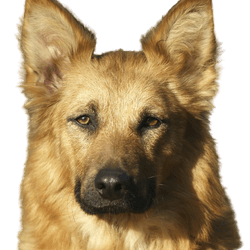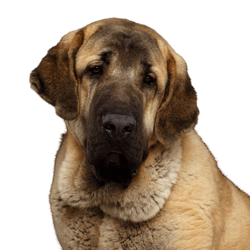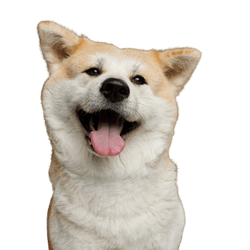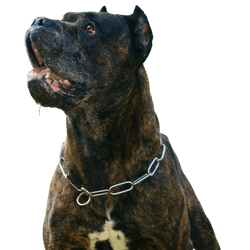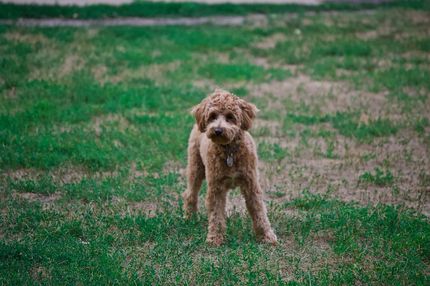
Great Dane Breed description: Character & Co
Great Dane
Facts & Origin
The Great Dane has been among the ten most popular dog breeds in Germany for years. On here we want to present to you the most important facts about these gentle giants - from their appearance, their keeping and nutrition to their breeding. If you want to buy a Great Dane, you should get a lot of information in advance, because we may allow ourselves to say as much as this: Keeping a Great Dane is neither easy nor cheap and should therefore be very well considered. We hope to be able to provide a little help for your decision making process.
Although Great Danes are blessed with a good-natured and friendly character, this spirited dog does not allow the conclusion that they are easy to handle or even suited for first-time dog owners. Their size alone often presents great difficulties for inexperienced dog owners. Consistent and professionally instructed training from an early age is essential for the keeping of dogs this size. Even when the dog is on a leash, its strength makes it difficult to exercise control over them once they decide to break free. Great Danes are very capable and willing to learn and also willing to be led. However, it reacts very sensitively to restrictive measures of any kind and is not forgiving when it comes to educational mistakes. We therefore strongly recommend professional dog training.
Origin and history of the Great Dane
The possible origin of the Great Dane could go all the way back to 5,000 B.C., but since there is no clear proof for these findings, a definite origin can only be determined after the 16th century. At that time, crosses between Mastiffs and Irish Wolfhounds were bred in England, which were named English Docks. These animals were excellently suited for hunting, as they were strong, fast and aggressive enough to be used to fight off bears and wild boars. When firearms were introduced into hunting, the Great Danes lost their reasons to exist as
- hunting dogs and were henceforth bred as
- watch- and
- society dogs for private households.
Since completely different character traits were required, the breeding was adapted accordingly.
Only in 1876 the name Great Dane became generally accepted. In 1888 the first breeding club in Germany was founded in Berlin - the Great Dane Club, of which there is also on existing in Austria called Dogge Club.
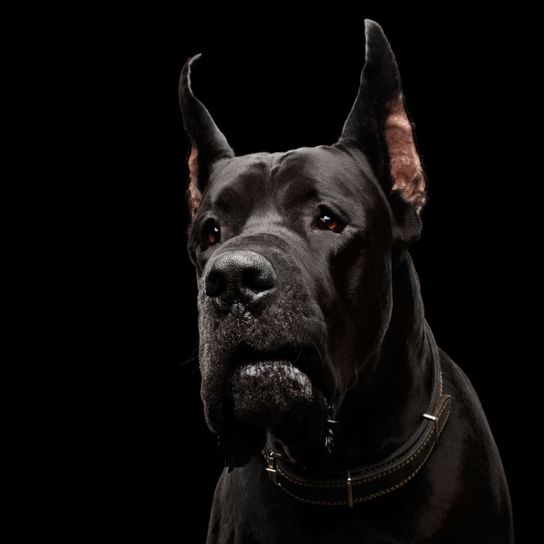

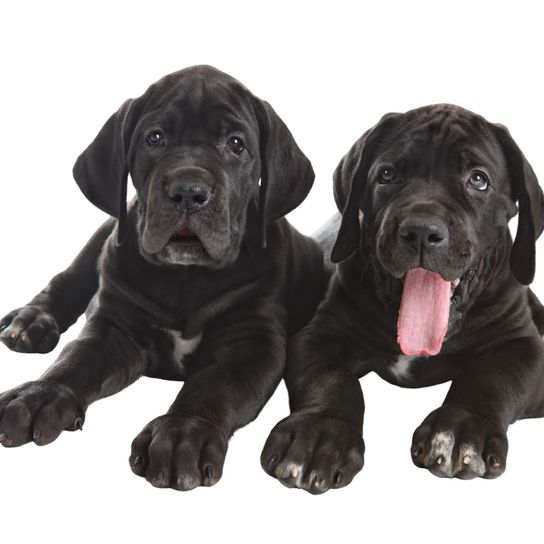
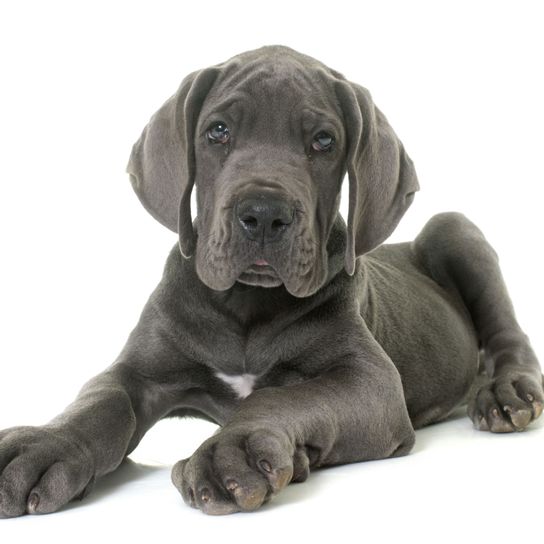
| Alternate Name | Great Dane |
| Origin | Germany |
| Life expectancy | 8 - -3 years |
| Care requirements | low-maintenance |
| Activity level | high |
| FCI group | Molossian type |
| AKC group | working group |
| KC group | working group |
Great Dane mixes
Attitude, character and temperament of the breed
Nature and personality - the temperament of the Great Dane
As big as these dogs are, they have a gentle, balanced and friendly nature slumbering inside. The Great Dane has a very high stimulus threshold and is also very good-natured towards children and other pets, provided it is well socialised. Great Danes are characterised by their above-average intelligence and high learning ability. They are very affectionate and people-oriented and therefore absolutely have a need for a family connection. It is often difficult for Great Danes to be temporarily separated from their caregivers. Their character can be described as very alert and fearless, but not as aggressive.
Character
Usage





Health and breeding information
Keeping and education of the Great Dane
If you want to buy a Great Dane, you should be aware that food alone for an animal of this size means a considerable financial expense. It is also not advisable to keep a Great Dane in a small apartment, where it does not get enough exercise. The logistical effort of keeping such a large dog should not be underestimated. The animal must be transported regularly. What would happen to a sick dog that is no longer able to walk by itself? All these questions should definitely be clarified before deciding on getting one of these dogs.
Breed-typical diseases of the Great Dane
Unfortunately, the Great Dane is prone to suffering from various diseases. The following diseases occur in this breed more frequent than average:
- various types of cancer, especially bone cancer
- twisting of the stomach
- Joint Dysplasia
- Dilated Cardiomyopathy (heart muscle disease)
Great Dane breeding
The most important thing in breeding is that only healthy dogs are considered for mating. Great Danes usually birth 6-7 puppies. As these animals grow very quickly and the success of compatibility with the owner can not be guaranteed in the beginning, you should definitely take into account the amount of space required for appropriate keeping. To earn money with a high quality breeding is very difficult, because considerable investments have to be made and the running costs are also quite high. If you would like to buy a puppy, make sure you get a renowned breeder and don't be fooled by supposedly low prices. These animals are often sick and poorly socialised, so that follow-up costs can be unexpectedly high.


The appearance of the Great Dane
The Great Dane has a very short, thick and smooth coat. Concerning the colour of the coat, the breed standard defines five different types: yellow, brindle, spotted, black and blue. The build of the breed can best be described as large, strong and elegant. The body of the bitch is somewhat longer than that of a male dog, which almost appears square. The head of the Great Dane is very expressive and ideally appears harmonious in proportion to the body. This well-proportioned and sublime physique, which reminds of a statue, gave the Great Dane also the reputation as "Apollo of the dog breeds".
Life expectancy of the Great Dane
Unfortunately this breed belongs to the most short-lived dog breeds in the world. On average, the animals only live six to seven years. Only a quarter of all dogs of this breed will be older than eight years. Generally, it is fair to say, that life expectancy decreases the bigger the animal and the more unusual its coat colour. Bitches usually reach a higher age than males.
Size and weight of the giant dog breed
The largest Great Dane in the world so far, the male George, reached a height of 109 cm measured at the withers and a weight of 111 kg. Of course, these values are not commonplace. Nevertheless, the Great Dane belongs to the largest dog breeds in the world.
The breed standard of the FCI specifies a minimum size of 80 cm for males and 72 cm for bitches.
The ideal weight of the Great Dane is defined as approx. 50 kilograms, however, there are also larger specimens, which can easily reach 80 - 90 kilograms.
The ears and tail were often docked or made to stand up in the past. The former is now forbidden and rarely to be seen anymore. To make their ears stand up is exclusively for aesthetic purposes - this is however also controversial and does not occur very often anymore.
| Fur length | short |
| Fur | flat coated |
| Ear shape | Floppy Ear |
| Tail | lang |
| Anatomy | slim, strong, sporty, square |
| Size ♀ | 76 - 86 cm |
| Weight ♀ | 45 - 59 kg |
| Size ♂ | 71 - 81 cm |
| Weight ♂ | 54 - 90 kg |
| Suitable For | - |
Colors






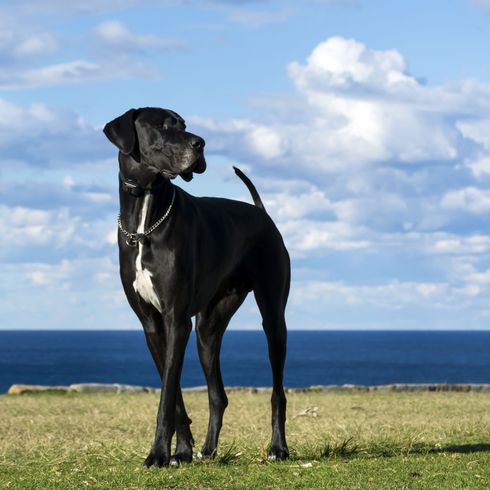


Known Diseases
dilated cardiomyopathy
Dilated cardiomyopathy is a disease of the heart muscle in which it becomes enlarged (dilated) and shows poor contraction (poor pumping ability).
Joint problems
Especially due to overweight, joint problems can occur in dogs.
Bone Cancer
May occur with age.
Cancer
May be common in older dogs.
Gastric torsion
Gastric torsion is a disease in which the stomach rotates around its own longitudinal axis. The cause of the disease is not known.
Ataxia
Ataxia (from Greek ἀταξία ataxia 'disorder' 'irregularity') is a generic term in medicine for various disorders of movement coordination. Ataxia can occur even when there is no paralysis (paresis), that is, when there is normal muscle strength.
FAQ
-
A purebred Great Dane costs about 3000 Euro.
-
The word Great Dane comes from the English dog and simply means dog.
-
Yes, the Great Dane is the largest dog breed in the world. The biggest dog in the world according to the Guinness Book of Records is Freddy and lived in England.
Other large dogs
Useful Articles
You can find articles that might interest you in the dogbible blog to match your favorite breed.
Visit our magazineto stay up to date on dog trends.
To find out more, view our Privacy Policy
Find here the breed that suits you and find out what character traits it has. Here you can also learn more about the origin, size and weight of your favorite breeds.
Matching your favorite breed, you'll find articles that might interest you on the dogbible dog blog.
Relaxed walking on the leash in spite of other dogs - 3 tips for leash leadership
Holland trip with dog - these are the most beautiful places
Kong filling - recipes for really tasty Kong fillings
Hiking holiday with dog - this is what you should keep in mind!









